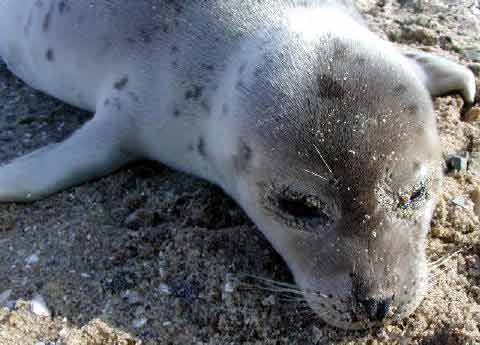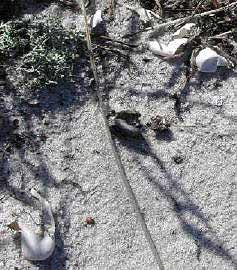Seals and Dolphins and Turtles, Oh My! — 30 January 2002It’s almost time for the calendar to turn into the shortest and oft harshest month of the season. Yet in this year without winter — at least out here at the edge of the known terrapin universe, every day has been accessible for field research, filled with adventure and discovery. Since Sunday, temperatures have soared into the mid-50s and even if Phil does see his shadow next Saturday, six more weeks until spring sounds too good to be true. But we’ll take it anyhow. With full moon in the Land of Ooze comes extraordinary tides with highs scaling up over 12 feet and lows plunging into the deep minus zone. So, critters have another challenge to face. Blown into Wellfleet Harbor by a southwesterly breeze and coasting with the strong tidal inflow, once they get deep into the northern marshes and mud flats, the bottom falls out. Strandings! Sunday the Cape Cod Stranding Network, under its program director Katie Touhey, rescued 17 common dolphins from Duck Creek, as far to the northeast as one can get in Wellfleet Harbor (see Cape Cod Times, 29 January 2002). As usual, a whole community of volunteers pitched in to help the Stranding Network. They included the New England Aquarium, the International Fund for Animal Welfare, the International Wildlife Coalition, park rangers from the Cape Cod National Seashore, and local Wellfleet police and our harbor master staff. So, this morning when Katie called, I thought the bell had rung again for another dolphin event. Instead, she asked if I would check out reports of a seal on the east/Atlantic coast of Orleans in a landing protected by the dune arm of Nauset Beach.
During this year without a real winter (unlike last season), I’ve encountered no harp seal pups resting in Wellfleet marshes. And while I’ve responded to several other seal calls up and down the coastline, this one represented my first harp of the year. Her breathing was quite labored and she seemed to have been under stress for a while. After my phoned assessment, the Stranding Network dispatched a team to take care of her. | |||||||||
 On Sunday while others tackled the dolphin strandings, I explored Namskaket Creek on the west/bayside coast of Orleans. Last June a beach walker had discovered a diamondback terrapin hatchling crawling the dunes of nearby Crosby Beach. In March 2000 the fresh remains of a mature, 9-year-old female terrapin was found at Linnell Landing a little to the east. With these data points and some anecdotal reports of turtle sightings over the last decade, we speculated that an unconfirmed breeding population of diamondback might reside in the marshes of Namskaket Beach.
|
 Speaking of terrapins, and one should always talk terrapin whenever opportunity permits, the surprise hatchling from Great Island that was recovered on 18 January has had enough socializing, thank you. She spent the better part of two days soaking up heat and fluids to compensate for her severe dehydration. Then she crawled over to the other corner of her faux marsh environment, found the perfect spot protected by salt hay, and began digging. Within an hour only the top of her carapace was visible. By the next morning, she had taken subterranean refuge, heading back into her interrupted brumation. “See you in the spring, Don. Give my regards to Punxsutawney.” The other terrapin house guest, Bubbles (a.k.a. #1195) had a fun day, too. With temperatures so pleasant, I took the opportunity to refresh her aquarium where she’s been feasting on shellfish for the last few weeks. When found injured on 16 October, Bubbles hit the scales at 1283 grams. Under treatment for her traumatic wounds, she had fasted for several months and by the time she resumed eating, she had lost almost 200 grams of weight. Since then, her diet of tidal shrimp and shellfish has brought her back to within striking distance of her former self. To give her a little exercise and direct sun exposure, I let her romp around the backyard marsh of Connemara Cottage.
As you can see, her wounds were quite severe, rupturing her carapace and crushing her left bridge. But things seem to be knitting back together, albeit slowly, and under the terrific care of the veterinary staff at the U.S. Humane Society rehab center in Barnstable, I’m anticipating a full recovery and release into the wild on/about 1 May 2002. And last, but certainly not least and never to be forgotten, is Darth — the 30-pound male snapper who was run over this last summer and is recuperating in my garage. He, too, had his faux habitat refreshed to ensure a nice, healthy brumation. When I approached his container, which remains out of the way to allow him a quiet and peaceful slumber, I began to get concerned. Darth has had some severe wounds and we knew his case was experimental. Still . . . there was no movement when I lugged his container outside, nor was there any sign of life when I emptied the water so I could remove Darth to “dry dock” while I cleaned everything out. Concern became worry as he remained unmoved at the bottom of his tank. But when I lifted my fine friend, he invoked his best Vader-esque voice to let me know, in no uncertain terms, that he was ticked to be disturbed in the middle of his winter nap. An alternative theory is that Darth was playing possum and hoped I might provide a welcomed bite — so to speak — to break his long fast on this spring-like day. Whatever his game, Darth was safely maneuvered into dry dock and back into his refreshed “pond” for the balance of the season. |
|
Who said in winter a field researcher has nothing to do but write up findings? Heck, I have a lot of fun just counting my fingers after each encounter with my less-than-sociable house guests. |



